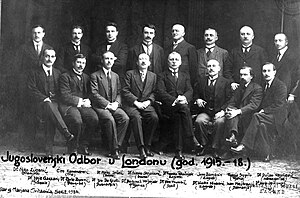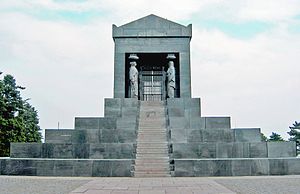| Part of a series on |
| Yugoslavs |
|---|
 |
| By region |
| Culture |
| History |
| Languages |
| People |
|
| Ethnicities |
Yugoslavism, Yugoslavdom, or Yugoslav nationalism is an ideology supporting the notion that the South Slavs, namely the Bosniaks, Croats, Macedonians, Montenegrins, Serbs and Slovenes, but also Bulgarians, belong to a single Yugoslav nation separated by diverging historical circumstances, forms of speech, and religious divides. During the interwar period, Yugoslavism became predominant in, and then the official ideology of the Kingdom of Yugoslavia. There were two major forms of Yugoslavism in the period: the regime favoured integral Yugoslavism promoting unitarism, centralisation, and unification of the country's ethnic groups into a single Yugoslav nation, by coercion if necessary. The approach was also applied to languages spoken in the Kingdom. The main alternative was federalist Yugoslavism which advocated the autonomy of the historical lands in the form of a federation and gradual unification without outside pressure. Both agreed on the concept of National Oneness developed as an expression of the strategic alliance of South Slavs in Austria-Hungary in the early 20th century. The concept was meant as a notion that the South Slavs belong to a single "race", were of "one blood", and had shared language. It was considered neutral regarding the choice of centralism or federalism.
The Yugoslavist idea has roots in the 1830s Illyrian movement in Habsburg Croatia, where a group of intellectuals saw the unity of South Slavs within the Austrian Empire or outside of it, as a protection against Germanisation and Magyarisation. Cooperative talks began with Serbian politicians and working to standardise Serbo-Croatian as a common language with orthographer Vuk Karadžić, with limited success. Following the Austro-Hungarian Compromise of 1867, the concept was rivalled by Trialism. Control of the Balkans by the Ottoman Empire and Austria-Hungary prevented practical implementation of Yugoslavist ideas until the Ottomans were pushed out of the Balkans in the 1912 First Balkan War and Austria-Hungary disintegrated in the final days of the First World War. During the war, preparations for unification began in the form of the Niš Declaration of Serbian war aims, establishment of the Yugoslav Committee to represent South Slavs living in Austria-Hungary and adoption of the Corfu Declaration on principles of unification. The short-lived State of Slovenes, Croats and Serbs was proclaimed in the South Slavic lands formerly ruled by the Habsburgs at the end of the First World War. Its leadership primarily wanted unification with Serbia on a federal basis, while Serbia preferred a centralised state.
The unification took place on 1 December 1918, when the Kingdom of Serbs, Croats and Slovenes was proclaimed. In the first years of the new kingdom, politics became increasingly ethnic as individual political parties became identified with particular nations within the country. Similarly, integral Yugoslavism became associated with the regime, and the political struggle against the government was increasingly equated with the ethnic struggle between the Serbs (identified with the regime) and various ethnic groups – most often the Croats as the most vocal political opposition to the regime. Alliances shifted over time and were not always ethnic-based. They depended largely on the form of Yugoslavism adopted by those concerned. The outcome of the political debates of the first few years of the new country resulted in the Vidovdan Constitution – deemed illegitimate by many – and in regime- and opposition-sponsored violence. The state abandoned integral Yugoslavism in 1939 when a settlement was reached with the Croat opposition leader Vladko Maček with the Cvetković–Maček Agreement. The regime attempted to unify the common language. Lack of standardisation of Serbo-Croatian brought about the practice of publication of official documents in the Ekavian speech favoured in Serbia, often in Cyrillic script not normally used by the Croats or the Slovenes to write. The Serbian Orthodox Church was given preference by the regime. The regime tried reducing the power of the Catholic Church in the Kingdom, promoting conversions and rival churches, and refraining from ratification of the Concordat with the Holy See over Serbian Orthodox Church protests. Before the First World War, a synthetic Yugoslavist culture was largely confined to Croat artists and writers. Ivan Meštrović became the most prominent among them at a 1911 exhibition in Rome. Disillusioned after the unification, most artists and writers distanced themselves from the synthetic culture.
After the Second World War, the Communist Party of Yugoslavia (KPJ) ruled the country. The KPJ adopted a formal commitment to federalism in a highly centralised state, promoting social Yugoslavism and a diversely interpreted notion of "brotherhood and unity". The 1948 Tito–Stalin split pushed the KPJ to gradual decentralisation until the mid-1950s, when a Yugoslavist campaign was launched to reverse the course, leading to a debate on levels of decentralisation. Centralist forces were defeated by the mid-1960s. Significant decentralisation occurred during, and in the aftermath of, the Croatian Spring. In 1987, Slovenian intellectuals cited Yugoslavism as the main threat to Slovenian identity. The issues raised by them contributed to the motivation for a 1990 proposal to restructure Yugoslavia as a confederation and for subsequent Slovenian and Croatian declarations of independence marking the breakup of Yugoslavia.









